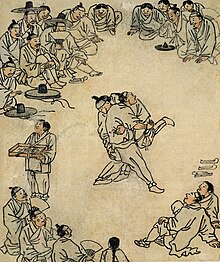Cheonhajangsa Ssireum Championship

The painting titled "Sangbak" (상박; 相撲) drawn by Kim Hong-do illustrates people gathering around to watch a ssireum competition in the late 18th century.
|
|
| Also known as | gakjeo; gakhui; gakryeok; gakgii; chiuhui; sangbak; jaenggyo |
|---|---|
| Focus | Grappling |
| Hardness | Full-contact |
| Country of origin | Korea |
| Creator | Unknown |
| Parenthood | Historical |
| Olympic sport | No |
| Ssireum | |
| Hangul | 씨름 |
|---|---|
| Revised Romanization | ssireum |
| McCune–Reischauer | ssirŭm |
Ssireum (Hangul: 씨름) or Korean wrestling is a folk wrestling style and traditional national sport of Korea.
In the modern form each contestant wears a belt (satba) that wraps around the waist and the thigh. The competition employs a series of techniques, which inflict little harm or injury to the opponent: opponents lock on to each other's belt, and one achieves victory by bringing any part of the opponent's body above the knee to the ground.
Historically, with the introduction of Chinese culture, there have been other terms for "wrestling" in Korean used alongside ssireum, such as gakjeo (각저:角抵), gakhui (각희:角戱), gakryeok (각력:角力), gakji (각지:角支), chiuhui (치우희:蚩尤戱), sangbak (상박:相撲), jaenggyo (쟁교:爭交).Gak (각:角), a commonly used prefix, seems to have originated from the combative act performed by horned animals such as oxen when competing against one another for the superiority of physical strength.
Ssireum first gained widespread popularity during the Joseon Dynasty (1392–1910). Evidence of this is shown through the genre pictures of Kim Hongdo (see the above picture, Sangbak (상박:相撲)). In traditional life, Ssireum was a popular activity on the Korean holiday of Dano, the fifth day of the fifth lunar month, and tournaments are held in the summer and autumn. Ssireum competitions were also held on other days such as the Third Day of the Third Moon, the Eighth day of the Fourth Moon, Buddhist All Souls’ Day, etc.. The traditional prize for winning a tournament was an ox, a valuable commodity in agriculturally-oriented society, which symbolized the strength of the contestant.
The modern sport has developed in the 20th century. The first modern competition was held in 1912 at the Dansongsa theater in Seoul. Korean wrestling has been referred to as ssireum since the 1920s. The Pan Chosun Ssireum Federation was founded in 1927. Since 1947 the competition organised by the Ssireum Federation has been called the National Ssireum Championship Contest. Weight classes were introduced at the 12th National Ssireum Championship Contest, and revised in 1967. There are two traditional styles of Ssireum: a "right sided" style predominant in parts of the Gyunggi province, and Honam province of southern Korea, and a "left side" style favoured in Hamgyung province, Gyungsang province and Choonchong province. The difference depended on the way the satba was fastened. In 1994, the Korean Ssireum federation, chaired by Hong sup Kim, proposed the unification of Ssireum in a single style and left sided Ssireum was adopted as the official style to be used by all competitors.
...
Wikipedia
